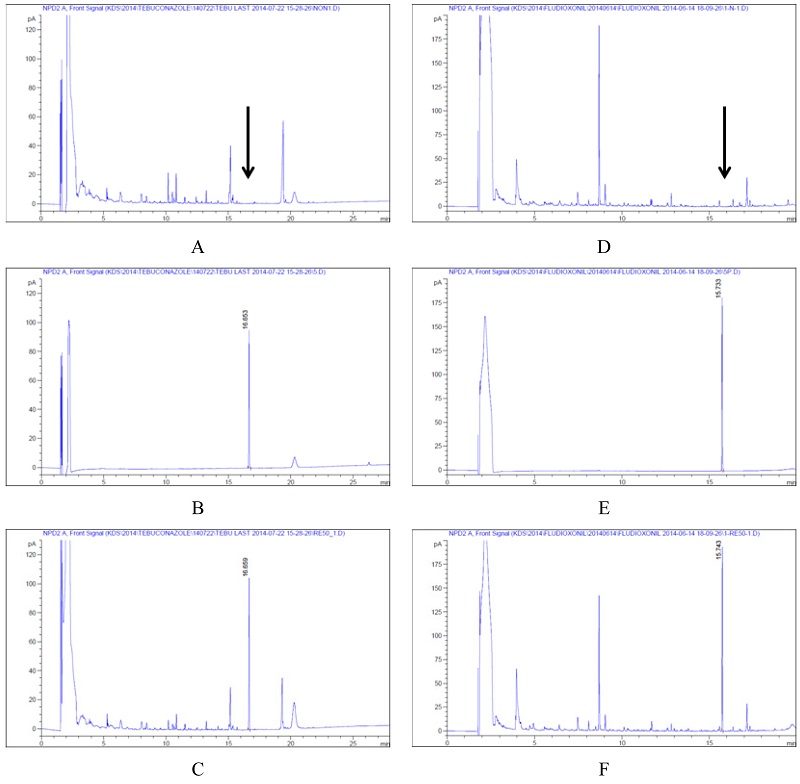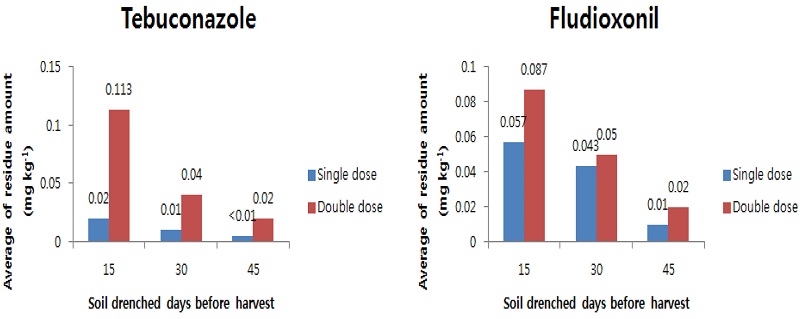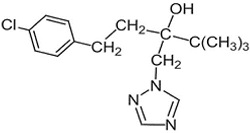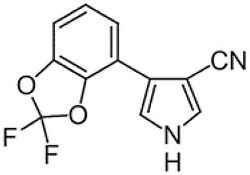
소면적 재배작물 산마늘(Allium ochotense Prokh.) 중 살균제 Tebuconazole 및 Fludioxonil의 잔류특성
초록
본 연구는 소면적 재배작물인 산마늘을 대상으로 tebuconazole 및 fludioxonil의 잔류특성을 조사하여 잔류허용기준(MRL) 및 안전사용기준 설정을 위한 자료로 활용하고자 수행하였다. Tebuconazole 20% 액상수화제 및 fludioxonil 20% 액상수화제 농약을 기준량과 배량의 농도로 토양관주처리한 후, 15, 30, 45일차에 시료를 채취하여 분석하였다. 두 약제 모두 dichloromethane을 이용하여 분배하였으며, SPE-Silica cartridge와 SPE-NH2 cartridge를 사용하여 정제한 후, GC/NPD를 이용하여 분석하였다. Tebuconazole과 fludioxonil의 회수율은 각각 108.8~119.5%, 91.3~104.8%였으며, 이 때의 분석검출한계는 모두 0.01 mg kg−1이었다. 산마늘 중 tebuconazole의 잔류량은 <0.01~0.12 mg kg−1이었으며, fludioxonil의 경우 0.01~0.09 mg kg−1이었다. 두 약제의 잔류량으로부터 산출한 ADI 대비 식이섭취율(% ADI)은 각각 17.44%, 25.75%로 산마늘 중 tebuconazole 및 fludioxonil에 대한 ADI 대비 식이섭취율(% ADI)은 80%를 초과하지 않으며, 식이를 통한 두 약제의 노출 위험도는 안전한 수준인 것으로 판단된다. 이에 따라 tebuconazole 20% 액상수화제 및 fludioxonil 20% 액상수화제는 산마늘의 병해를 방제하는데 활용할 수 있으며, 잔류농약 문제를 효율적으로 관리할 수 있을 것이라 판단된다.
Abstract
In recent years, Allium victorialis has been extensively used as a pharmacological agent for various diseases in the form of anti-arteriosclerotic, anti-diabetic and anti-cancer. Allium victorialis is severely affected by various fungal diseases since it naturally grow in the shady and humid environments in Korea. In this case, different types of fungicides are applied to control the fungal diseases in Allium victorialis. The present study was aimed to determine the residual characteristics of two fungicides namely tebuconazole and fludioxonil on Allium victorialis. For this study, the fungicides were drenched soil on Allium victorialis in the cultivation area Pyeongchang by the standard (two thousand fold) and double (thousand fold) dilutions. At the end of 15th, 30th and 40th days samples were collected for residue analysis. Residues of tebuconazole and fludioxonil were analyzed using GC/NPD (Gas Chromatography/Nitrogen Phosphorus Detector) and their recovery were found to be 108.8~119.5% and 91.3~104.8%, respectively. The method of limits of quantification for both fungicides was 0.01 mg kg−1. Further, the results of this study shows that the residue levels of both fungicides on Allium victorialis were <0.01~0.12 mg kg−1 and 0.01~0.09 mg kg−1 and their % ADI (% Acceptable Daily Intake) were 17.44% and 25.75%, respectively. Based on the results obtained in this study, we suggest that the residue levels of both of the fungicides on Allium victorialis are safe and these fungicides can also be used to control fungal diseases in Allium victorialis.
Keywords:
Allium victorialis, Pesticide residue, Tebuconazole, Fludioxonil키워드:
산마늘, 잔류특성서 론
국민의 소득향상과 함께 식생활이 개선되면서 신선채소에 대한 소비자들의 수요가 증가하고 있다. 이에 따라 특용작물과 엽채류, 산채류 등이 속한 소면적 재배작물에 대한 관심이 증가하여 재배면적과 재배작물이 다양화 되고 있다(Jeon, 2014). 그러나 국민의 식생활 안전을 위해 실시하는 국립농산물품질관리원의 농산물 잔류농약 안전성 조사 결과에 따르면 286품목 91,211건 중 1,209건이 농약잔류허용기준을 초과하였으며, 산채류, 엽채류, 경채류 순으로 부적합 비율이 높아 소면적 재배작물에 대한 안전성 부적합 비율이 높은 것으로 나타났다(National Agricultural Products Quality Management Service, 2014). 또한 소면적 재배작물에 대한 농약잔류허용기준(Maximum Residue Limit, MRL)이 일반작물보다 많지 않아 병·해충을 방제하는데 어려움이 있으며, 소면적 재배작물의 안전성 관리를 위해 농약의 잔류양상에 대한 지속적인 연구 확대가 필요한 실정이다(Park et al., 2009).
소면적 재배작물 중 하나인 산마늘은 종자 파종에서 수확기까지 4년에서 5년 정도 소요되는 작물로 잎·줄기 부분을 식용으로 한다(Rural Development Administration, 2015). 그늘지고 습한 환경에서 재배되는 특성으로 인해 잎마름병, 흰비단병 등의 병해가 발생하고 있으나 현재 산마늘에 대한 농약 선택의 폭이 넓지 않아 병해를 방제하는데 어려움을 겪고 있다(Ministry of Food and Drug Safety, 2015; Kwon, 2013). 잎마름병은 산마늘에 가장 피해를 많이 주는 병으로 알려져 있으며, 흰비단병은 최근 많이 발생하는 병으로 종묘생산 단계부터 피해를 주어 급증하는 산마늘의 수요와 생산에 영향을 주고 있다(Gangwon Agricultural Research and Extension Services, 2014).
따라서 본 연구는 산마늘을 대상으로 흰비단병 방제를 위한 살균제 tebuconazole 및 fludioxonil의 잔류특성을 조사하여 잔류허용기준(MRL) 및 안전사용기준 설정을 위한 자료로 활용하고자 수행하였다.
재료 및 방법
시험약제 및 시약
본 연구에 사용된 tebuconazole (98.5%) 및 fludioxonil (98.5%)의 표준품은 Dr. Ehrenstorfer (Germany)에서 구입하여 사용하였으며, 살포 농약은 tebuconazole 20% 액상수화제(실바코플러스, 바이엘)와 fludioxonil 20% 액상수화제(사파이어, 신젠타)를 사용하였다. 두 약제의 이화학적 성질은 Table 1과 같다(Tomlin, 2009). 분석을 위해 사용된 acetone, acetonitrile, dichloromethane, n-hexane, ethyl acetate, methanol은 Merck (Germany)사로부터 구입하여 사용하였고, sodium sulfate anhydrous, sodium chloride는 DAEJUNG (Korea)사의 제품을 사용하였다.
시험포장 및 약제처리
시험작물인 산마늘의 품종은 울릉산마늘이며, 강원도 평창군 봉평면에 있는 강원농업기술원 특화작물시험장평창분소에서 시험을 수행하였다. Tebuconazole 및 fludioxonil의 시험 구획은 기준량, 배량으로 구획하였으며 길이 30 m × 폭 1 m의 면적에 약제처리별 3반복 배치하여 각각의 처리구 사이에 1 m의 완충구를 두고 시험을 수행하였다. 약제처리는 토양관주처리로 두 약제의 처리 방법은 Table 2와 같다.
시료채취 및 증체율 조사
Tebuconazole 및 fludioxonil의 시료채취는 기준량, 배량으로 토양관주처리 후 15, 30, 45일차에 수행하였으며, 채취한 시료(1.5 kg/구)는 시료봉투에 밀봉하여 아이스팩이 들어있는 아이스 박스에 보관하여 즉시 실험실로 운반하였다. 운반한 시료는 각 처리구에서 20개씩 무게를 측정한 후, 마쇄 및 균질화하여 분석 전까지 영하 20°C 이하의 deep freezer에 보관하면서 분석 시료로 사용하였다.
표준검량선 작성
Tebuconazole (98.5%) 및 fludioxonil (98.5%) 표준품 101.52 mg을 각각 100 mL acetone에 녹여 1000 mg L−1 stock solution을 조제한 후, 단계별로 희석하여 0.1, 0.2, 0.5, 1.0, 2.0, 3.0, 5.0 mg L−1의 working solution을 조제하였다. 그 후 각각 1.0 μL 씩 GC/NPD에 주입하여 나타난 chromatogram상의 peak면적을 기준으로 검량선을 작성하여 직선성을 확인하였다.
잔류농약 분석
Tebuconazole을 추출하기 위하여 세절한 시료 20 g에 acetonitrile 100 mL를 가하여 homogenizer로 10,000 rpm에서 3분간 마쇄·추출한 후, 추출액 중 acetonitrile을 감압여과하였다. 여액을 dichloromethane으로 각각 50 mL, 50 mL로 2회 분배한 후, anhydrous sodium sulfate층을 통과시켜 탈수 및 감압 농축한 뒤 dichloromethane 5 mL로 재용해 하였다. 정제는 SPE-Silica 1 g cartridge를 이용하였으며, dichloromethane 5 mL로 pre-washing한 후, 추출액 5 mL를 loading하여 버리고, 전개용매 1 (n-Hexane:ethyl acetate=90:10, v/v) 10 mL로 세정하였다. 이 후 전개용매 2 (dichloromethane:methanol=95:5, v/v) 4 mL로 다시 세정하였으며, 4 mL를 이용하여 tebuconazole을 용출시켰다. 용출액을 감압·농축하고, acetone 2 mL로 재용해하여 GC/NPD로 최종 분석하였으며, tebuconazole에 대한 기기 분석 조건은 Table 3과 같다.
Fludioxonil을 추출하기 위하여 세절한 시료 20 g에 acetonitrile 100 mL를 가하여 homogenizer로 10,000 rpm에서 3분간 마쇄·추출한 후, 추출액 중 acetonitrile을 감압여과하였다. 여액을 dichloromethane으로 각각 80 mL, 70 mL로 2회 분배한 후, anhydrous sodium sulfate층을 통과시켜 탈수 및 감압 농축한 뒤 dichloromethane 5 mL로 재용해 하였다. 정제는 SPE-NH2 1 g cartridge를 이용하였으며, dichloromethane 5 mL로 pre-washing한 후, 추출액 5 mL를 loading하여 버리고, 전개용매(dichloromethane:methanol=95:5, v/v) 4 mL를 이용하여 fludioxonil을 용출시켰다. 용출액을 감압·농축하고 acetone 2 mL로 재용해하여 GC/NPD로 최종 분석하였으며, fludioxonil에 대한 기기 분석 조건은 Table 4와 같다.
회수율 시험
분석법의 적합함을 확인하기 위하여 무처리구 산마늘 시료 20 g에 두 약제의 표준용액 1 mg kg−1 2 mL, 10 mg kg−1 1 mL를 각각 분석검출한계의 10배(0.1 mg kg−1), 50배(0.5 mg kg−1) 수준으로 정확히 가하고, 균일하게 혼합하여 30분간 방치한 후, 상기의 분석과정을 수행하여 회수율을 산출하였다.
잔류농약의 ADI 대비 식이섭취율(% ADI) 산출
산마늘에 대한 tebuconazole 및 fludioxonil의 식이섭취량인 EDI (Estimated Daily Intake)와 ADI (Acceptable Daily Intake)를 기준으로 구한 식이섭취율은 다음 식으로부터 산출하였다. 이 때 산마늘의 일일섭취량은 산채류의 일일섭취량인 8.59 g을 적용하였으며, ADI는 한국 성인의 평균 체중인 55 kg을 적용하였다(Ministry of Food and Drug Safety, 2014).
- • EDI (Estimated Daily Intake, mg/day/man) = 잔류농도(mg kg−1) × 8.59 g day−1
- • 성인의 일일섭취허용량= ADI (Acceptable Daily Intake) × 55 kg
- • ADI 대비 식이섭취율(% ADI) = (식이섭취량/일일섭취 허용량) × 100
결과 및 고찰
표준검량선 작성
산마늘 중 잔류농약 분석을 위한 표준검량선을 작성한 결과, Table 5와 같으며 두 약제 모두 상관계수(R2)가 0.99 이상으로 높은 직선성을 보여 분석법이 정량분석에 적합함을 확인하였다.
분석검출한계 및 회수율 시험
산마늘 중 tebuconazole 및 fludioxonil의 분석검출한계는 0.01 mg kg−1이었으며, 회수율은 tebuconazole 108.8~119.5%, fludioxonil 91.3~104.8%로 두 약제 모두 잔류농약 분석 회수율 범위인 70~120%와 변이계수(coefficient of variation, CV) 1.1~7.2%로 10% 이내의 기준을 만족하였다(Table 6). 따라서 본 연구에서 확립한 분석법은 산마늘 중 두 약제에 대한 잔류분석에 적용 가능한 분석법임을 확인하였다. 상기 분석 방법에 의한 tebuconazole 및 fludioxonil의 머무름 시간은 각각 16.66 min., 15.74 min.이었으며, GC/NPD로 분석한 시험약제의 회수율 및 대표적 크로마토그램은 Fig. 1와 같다.
산마늘의 증체율과 기상조건
약제살포 후 15, 30, 45일차에 채취한 산마늘의 증체율을 측정한 결과, tebuconazole의 경우 약제살포 15일 경과 후 5.78 ± 2.0 g, 30일 경과 후 9.65 ± 1.24 g, 45일 경과 후 18.2 ± 1.98 g였으며, fludioxonil의 경우 각각 5.01 ± 1.59 g, 10.55 ± 3.18 g, 18.95 ± 1.9 g으로 두 약제는 비슷한 증체율을 보였다. 또한 시험기간 중 온도와 습도는 10.2~19.9°C와 43.6~87.4% 범위임을 확인하였다.
산마늘 중 Tebuconazole 및 fludioxonil의 잔류특성
Tebuconazole 및 fludioxonil을 기준량과 배량으로 1회 토양관주처리한 후 45일까지의 잔류량을 확인하였다(Fig. 2). Tebuconazole의 경우 약제 살포 15일 경과 후 기준량 처리 및 배량 처리 시 최대 잔류량은 각각 0.02 mg kg−1, 0.12 mg kg−1이었으며, 30일 경과 후 각각 0.01 mg kg−1, 0.04 mg kg−1이었다. 45일 경과 후 기준량 처리 시 검출한계 미만으로 나타났으며, 배량 처리 시 0.02 mg kg−1이었다. Fludioxonil의 경우 약제 살포 15일 경과 후 기준량 처리 및 배량 처리시 최대잔류량은 각각 0.06 mg kg−1, 0.09 mg kg−1이었으며, 30일 경과 후 각각 0.05 mg kg−1, 45일 경과 후 각각 0.01 mg kg−1, 0.02 mg kg−1이었다. 본 연구 결과, 토양관주처리 후 15일이 지난 후에도 잔류량이 나타났으며 이는 산마늘과 같은 엽채류의 경우 농약이 뿌리로 흡수된 후 바로 줄기와 잎을 통해 지상부로 상향 흡수·이행하여 잔류량이 나타난 것으로 사료된다(Jeon, 2014; Park 2004; Kim, 2014; Wallerstein, 1976). 그러나 두 약제 모두 시간이 경과함에 따라 잔류량이 감소하였는데 농작물의 중량에 대한 농도로 표시되는 농약의 잔류량이 작물의 성장에 의해 희석될 수 있다는 내용을 근거로 비교하였을 때 산마늘이 생장하면서 잔류농약이 희석되었기 때문인 것으로 보인다(Jeon, 2010; Kim, 2008). 따라서 농약의 분해 또는 소실에 영향을 주는 온도, 습도, 일조, 강우 등 기본적 요인뿐만 아니라 작물의 생장도 잔류농약의 농도를 감소시키는 요인이 된다는 것을 알 수 있었다(Jeong, 1990).
Tebuconazole 및 fludioxonil의 ADI 대비 식이섭취율(% ADI)
Tebuconazole 및 fludioxonil의 최대 잔류량은 각각 0.12 mg kg−1, 0.09 mg kg−1으로 두 약제의 최대 잔류량으로부터 산출한 ADI 대비 식이섭취율(%ADI)의 최대값은 각각 0.059%, 0.045%였다. 또한 두 약제에 대한 산마늘을 포함한 전체 작물의 ADI 대비 식이섭취율(% ADI)은 tebuconazole의 경우 17.44%, fludioxonil의 경우 25.75%로 나타나 산마늘 중 tebuconazole 및 fludioxonil에 대한 ADI 대비 식이섭취율은 80%를 초과하지 않았으며, 식이를 통한 두 약제의 노출 위험도는 안전한 수준인 것으로 판단되었다(Table 7, 8). 따라서 산마늘에 대한 tebuconazole 20% 액상수화제 및 fludioxonil 20% 액상수화제의 농약잔류허용기준(MRL)과 안전사용기준이 설정된다면 산마늘의 생산량 증가에 도움을 줄 수 있을 뿐만 아니라 안전사용기준 미설정 농약의 사용을 방지하여 안전성 수준을 개선하고, 잔류농약 문제를 효율적으로 관리할 수 있을 것이라 사료된다.
Acknowledgments
본 연구는 농촌진흥청 연구사업(2014년 소면적 및 수출유망작물의 작물잔류성 시험)의 지원에 의해 수행되었으며, 이에 깊이 감사드립니다.
References
- Jeon, S. O., (2014), Residue patterns of Fungicide Boscalid and Insecticide Chlorfenapyr in Korean Cabbage as a Minor Crop, Korea, p2-3.
- Jeon, Y. H., (2010), Residues of pesticides in a Kind of Minor Crop, Perilla Leaves, Korea, p4.
- Jeong, Y. H., and Y. S. Park, (1990), Korea Association of Farmers, Pesticide Science, p102.
-
Kim, J. Y., H. N. Kim, S. Manoharan, S. J. Heo, H. N. Jeong, J. E. Kim, K. R. Kim, and J. H. Hur, (2014), Translocation of Tolclofos-methyl from Ginseng Cultivated Soil to Ginseng (Panax ginseng C. A. Meyer) and Residue Analysis of Various Pesticides in Ginseng and Soil, Kor. J. Pesti. Sci, 18(3), p130-140.
[https://doi.org/10.7585/kjps.2014.18.3.130]

- Kim, K. T., (2008), Residual Characteristics of Insceticide Indoxacarb in Minor Crops, Korea, p2.
- Kwon, O. C., (2013), Stimulation of Seed Germination in Allium ochotense Prokh, Korea, p2.
- Park, H. J., J. H. Choi, B. J. Park, C. S. Kim, Y. B. Ihm, and G. H. Ryu, (2004), Uptake of endosulfan and procymidone from arable soil by several vegetables (green house study), Kor. J. Pesti. Sci, 8(4), p280-287.
- Park, J. H., M. I. R. Mamun, A. M. Abd El-Aty, J. H. Choi, G. J. Im, C. H. Oh, and J. H. Shim, (2009), Anextrapolation from crop classifications based on pesticide residues trial data within vegetables in minor crops, Kor. J. Pesti. Sci, 13, p28-38.
- Tomlin, C. D. S., (2009), The Pesticide Manual, British Crop Production Council, UK, p520-521.
- Tomlin, C. D. S., (2009), The Pesticide Manual, British Crop Production Council, UK, p1072-1073.
-
Wallerstein, I. S., B. Jacoby, and A. Dinoor, (1976), Absorption, retention and translocation of the systemic fungicide triarimol in plant, Pestic. Biochem. Physiol, 6, p560-537.
[https://doi.org/10.1016/0048-3575(76)90077-8]





